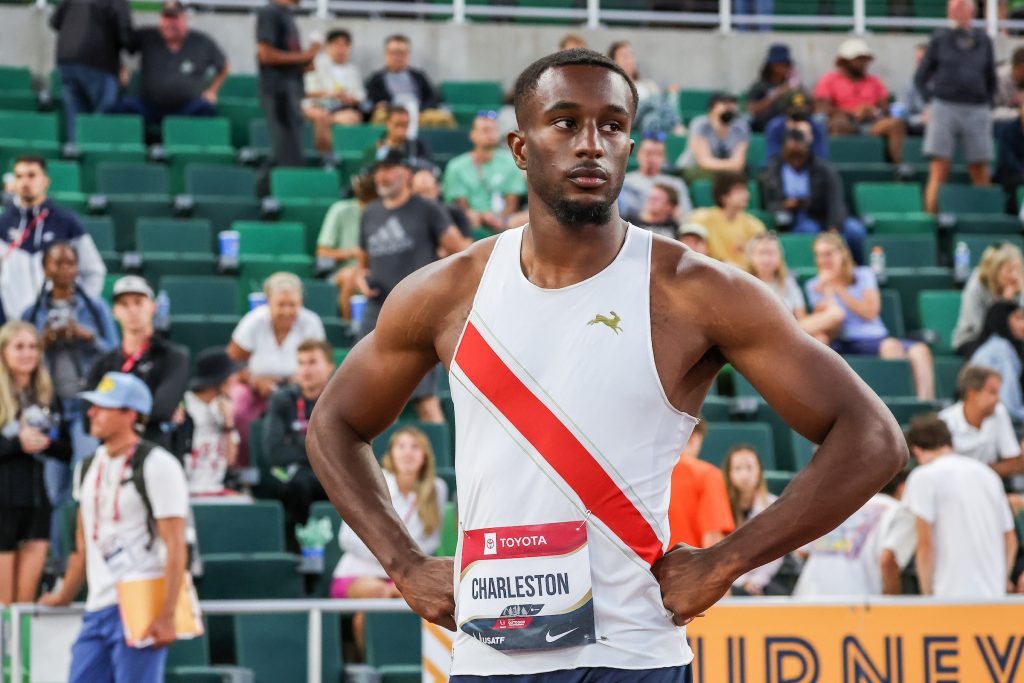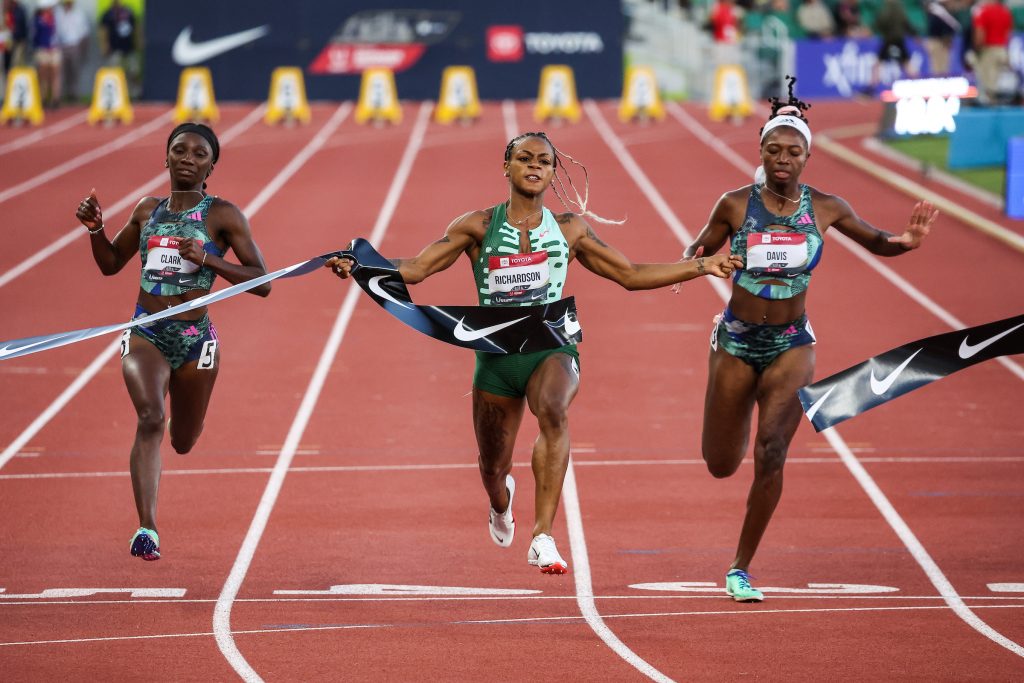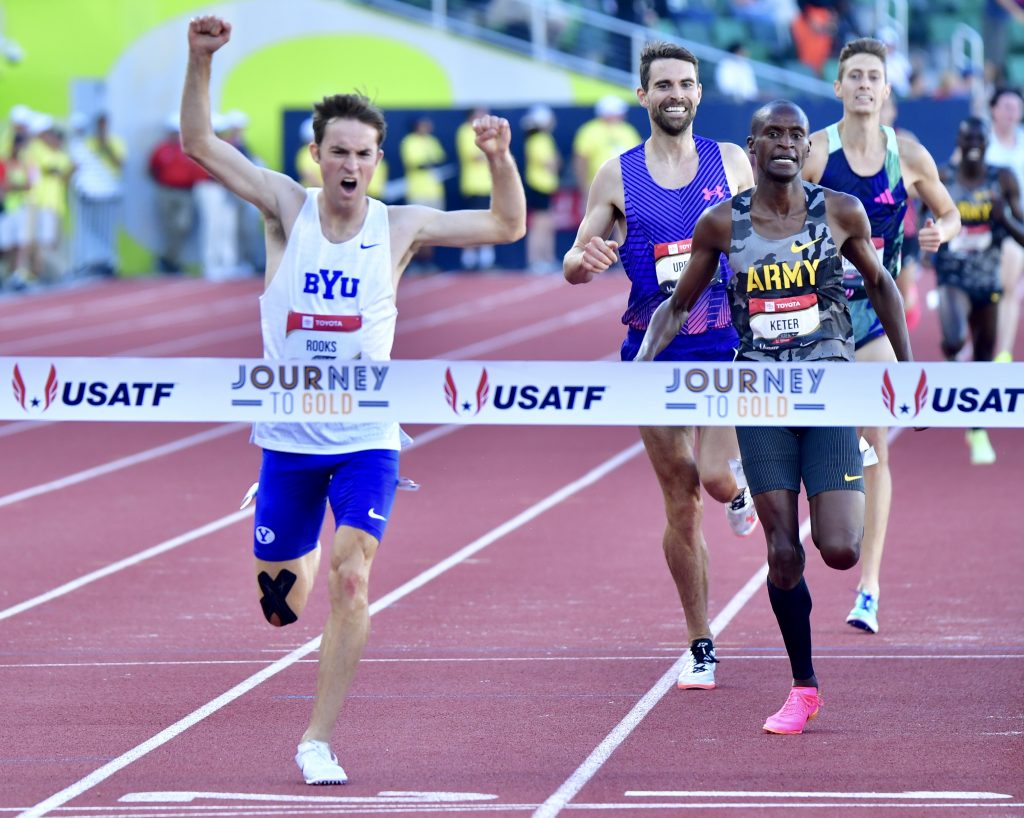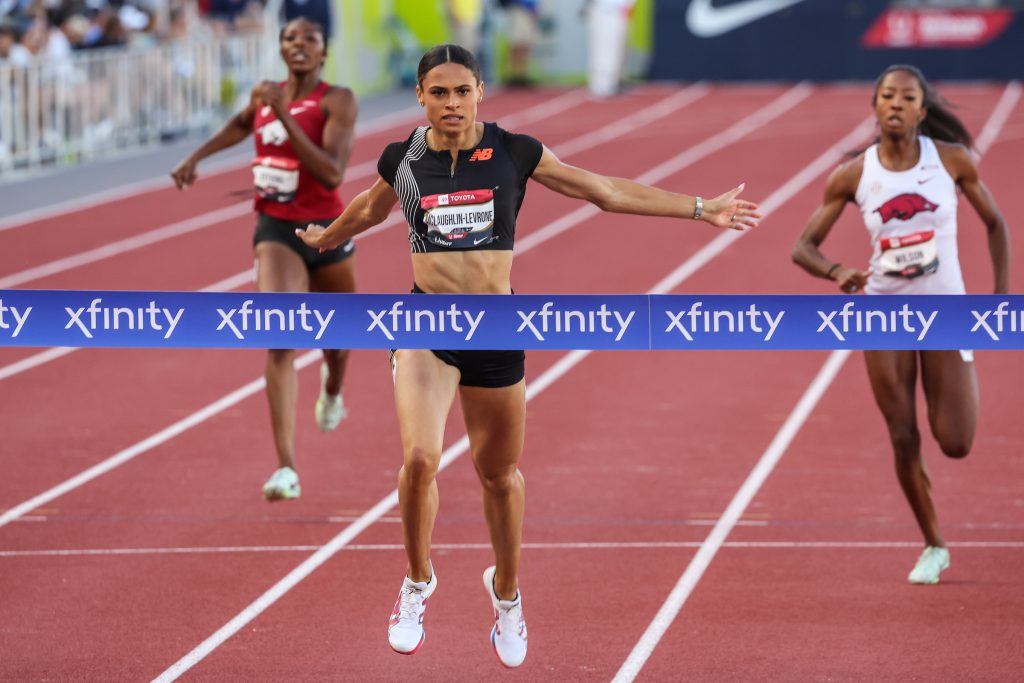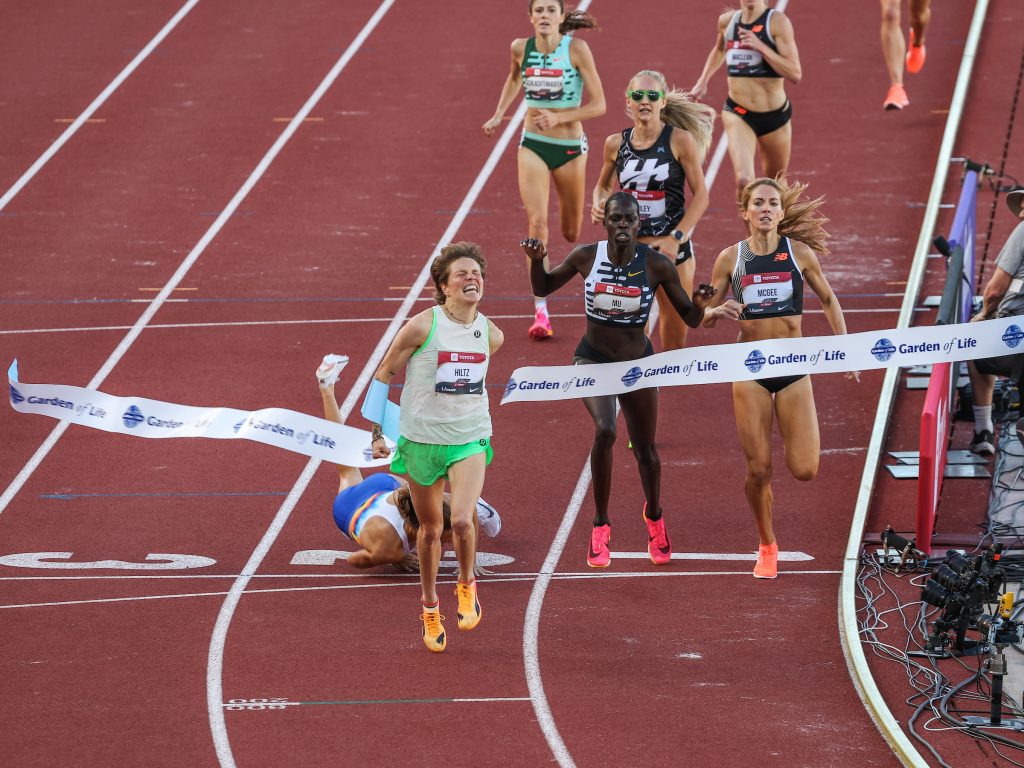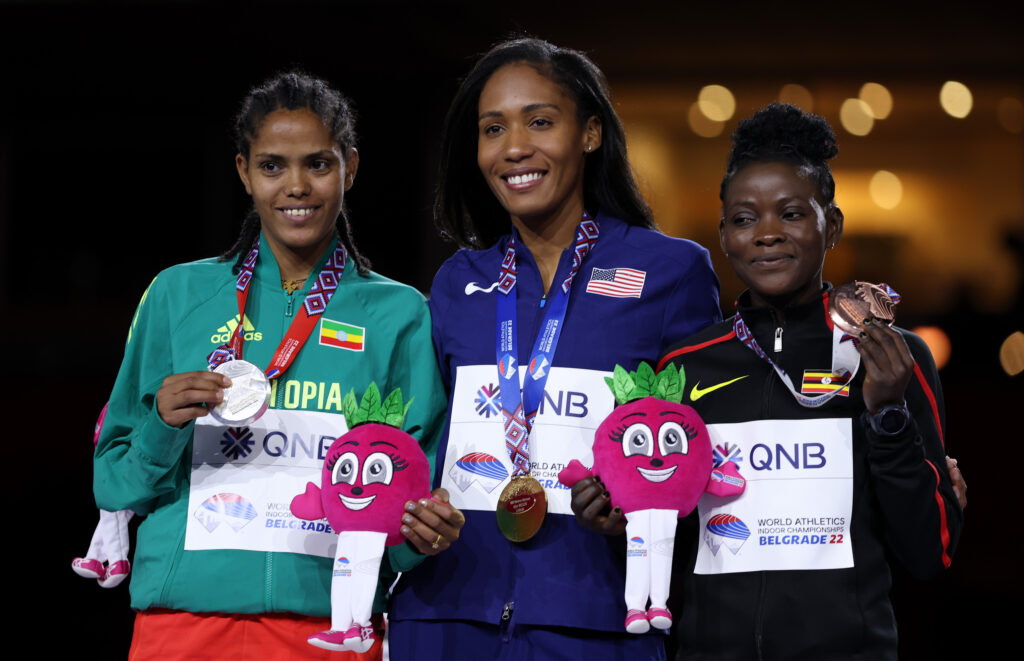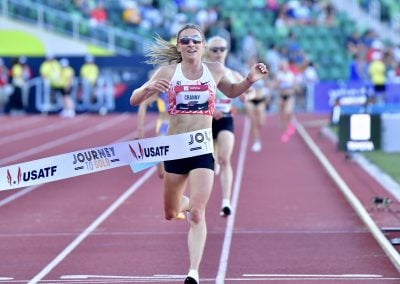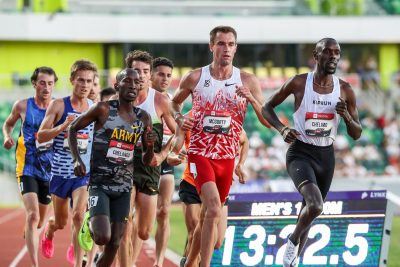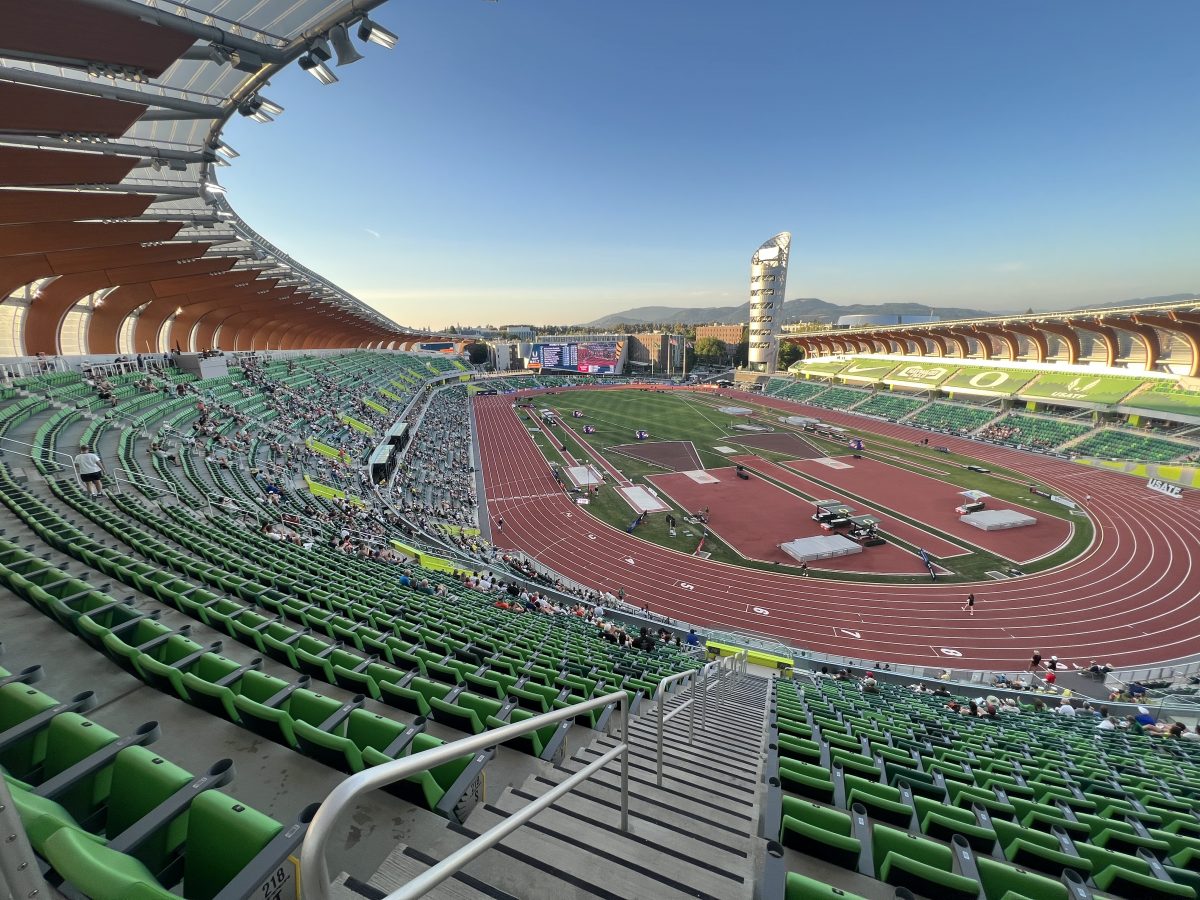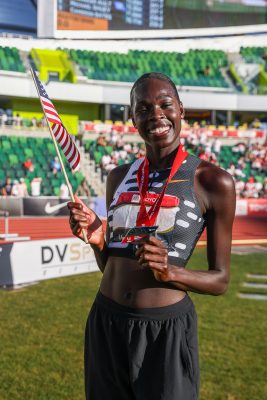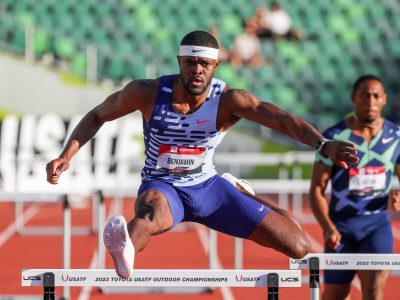Athing Mu Proves Doubters Wrong, How Was the Crowd in Eugene, & 6 More Thoughts on 2023 USAs
By Jonathan GaultThe 2023 USATF Outdoor Championships are in the books, and for those lucky enough to have made the team, they have a little over five weeks to rest up and refocus for the World Championships in Budapest (August 19-27) with Diamond Leagues in Silesia (July 16), Monaco (July 21), and London (July 23) still to come between now and then.
We had a ton of coverage from USAs on LetsRun.com. You can revisit all of our written recaps/analysis here, plus we recorded an episode of the LetsRun.com Track Talk Podcast for Supporters Club members after each night of competition. You can catch up on those by joining the LRC Supporters Club here.
But a lot of stuff happens over the course of a four-day meet, and it can be tough to put it all into context on deadline. Last year, with a few days to reflect, I shared my big-picture thoughts from USAs and I’m running it back in 2023. Without further ado, eight final takeaways from the weekend in Eugene.
Moments of the weekend
Cravont Charleston winning the men’s 100 meters
If you were paying attention this year, you knew Charleston, who had run 9.90, 9.91, and 9.95 before USAs was among the contenders to make the Worlds team in the 100. Charleston didn’t just make the team; he won the US title, taking down world champions Christian Coleman and Noah Lyles in the process. At the start of the year, Charleston had never made an NCAA or US final and was a relative unknown on the global sprint scene. He may end it as a World Championship medalist.
US women’s sprint stars explode
An American woman has not won a global title in the 100 or 200 meters since the late Tori Bowie‘s victory in the 100 at the 2017 Worlds in London. This year, the US has two genuine threats to end that drought in Sha’Carri Richardson and Gabby Thomas, both of whom were sensational in Eugene. Richardson started hot, blasting a 10.71 pb (#6 all-time) in the 100 prelims on Thursday, and though an underwhelming start slowed her time in Friday’s final, she won handily in 10.82 to secure her first (official) US title. After a windy 21.61 in the 200 prelims, it looked as if Richardson might double up, but 2021 Olympic bronze medalist Thomas responded in the final with a wind-legal 21.60 of her own to win the final, #4 all-time and the fastest by an American since FloJo’s 21.34 world record in 1988. Olympic champ Elaine Thompson-Herah failed to make the Jamaican Worlds team and Shelly-Ann Fraser-Pryce has been largely invisible in 2023 (she finally opened her season last weekend, running 22.26 for 2nd in the 200 at the Jamaican champs), but the Americans will still have their hands full in Budapest with Shericka Jackson, who ran 10.65 (t-#5 all-time) and 21.71 (into a 0.5 headwind) to sweep the 100 and 200 at the Jamaican championships.
The legend of Kenneth Rooks
When Rooks, this year’s NCAA champion for BYU, fell 800 meters into Saturday’s US steeple final, his coach Ed Eyestone began writing off the race. Rooks had enjoyed a fine season, and while Eyestone believed his athlete was in sub-8:10 shape, he has been around the sport long enough to know there is usually no coming back from a fall in a major steeplechase final. It’s not just the lost time — Rooks was more than two seconds behind the next-closest runner after his fall — but everything else that comes with it: regulating your breathing, staying calm, not rushing to make up the gap too quickly. Rooks did it all masterfully, moving up from 7th with 450m to run to 1st at the finish line (he even ran a personal best, 8:16.78) and earning some of the loudest cheers of the weekend from the Hayward Field faithful. Rooks’ comeback victory will go down as one of the most epic steeples in US history.
Sydney McLaughlin-Levrone runs a huge pb to win the 400
SML ran personal bests in her first two meets of 2023, 49.71 in Paris on June 9 and 49.51 in New York on June 24. But McLaughlin-Levrone has historically stepped it up a level during championship season — she has broken the 400m hurdle world record in each of her last four championship finals — and after running 49.79 in the prelims and 49.60 in the semis at USAs, it looked as if something special was on tap for Saturday’s final. SML delivered, ripping a massive .77 off her pb to run 48.74 to win the US title — #10 in world history and just .04 off Sanya Richards-Ross‘ American record. McLaughlin-Levrone has faced towering expectations ever since making the Olympic team as a 16-year-old in 2016. Year after year, she continues to meet them. Worlds will be very fun to watch if SML chooses the 400 (she has yet to decide on an event) and battles the Dominican Republic’s Marileidy Paulino, who has run 48.98 this year and beat SML in Paris.
Yared Nuguse and Nikki Hiltz prevail in thrilling 1500s
There are few events more thrilling in all of sports than a championship 1500 final. The event’s unpredictable nature and combination of speed, endurace, and tactics almost always makes for an exciting ending. The men’s and women’s finals at USAs were hyped as two of the races of the meet, and both delivered. In the men’s race, Joe Waskom launched a huge move with 230m to go and looked on track for an upset victory, but Nuguse responded like a champion and battled back to win his first US title. In the women’s race, Athing Mu looked as if she might win the national title in just her second professional 1500, but Hiltz kicked her down to win with Cory McGee edging a diving Sinclaire Johnson for 3rd by .01. So much drama.
Some familiar faces will be missing from Worlds this year
There is no room for nostalgia at the US championships. Past performance guarantees nothing. If you want to go to Worlds, you have to prove yourself each and every year (Editor’s note: Sadly, that’s not true for reigning world champions — they get a bye). And in 2023, there were a number of fixtures on previous US teams that will be watching Worlds on TV. Here are some of the big names who missed out.
- Ajee’ Wilson, 800m: There has been no more reliable performer at USAs over the past decade than Wilson, who made her first US team as a 19-year-old in 2013 and entered USAs having made 11 straight teams between indoor and outdoor track. But Wilson was last in the 800 final on Sunday, and revealed afterwards that she was not at 100% but refused to provide more details.
- Matthew Centrowitz, 1500m: Centro had never before tried out for a US team and failed to make it. He made his first team in 2011 and followed up with World/Olympic berths in ’12, ’13, ’15, ’16, ’17, ’19, and ’21. But Centrowitz missed USAs last year after undergoing knee surgery, and though he made it back to USAs in 2023, he was not a factor in the final and finished 10th.
- Courtney Frerichs, steeple: Frerichs has been a fixture on the US steeple team since making her first squad in 2016, earning World silver in 2017 and Olympic silver in 2021. But her comeback from ankle surgery last fall has been long and frustrating, and after a fall in Thursday’s prelims, Frerichs said the pain in her ankle was too great to run the final.
- Karissa Schweizer, 5k/10k: Schweizer still has slim path to Worlds but it seems unlikely at this point as it would require Bowerman TC teammate Elise Cranny giving up her spot and some combination of 3rd placer Natosha Rogers and 4th placer Weini Kelati not getting in via world ranking (Schweizer was 5th in the 10k and has the standard). But the fact that Schweizer had not raced at all until USAs and scratched the 5k on Sunday suggests she may not be healthy enough to run in Budapest regardless.
- Grant Fisher, 5k/10k*: Fisher gets an asterisk because he would be guaranteed a spot at Worlds in the 10k if his teammate Sean McGorty decides to run the 5k only in Budapest. But considering Fisher scratched the 5k at USAs with a stress injury in his femur, he, like Schweizer, may not be healthy enough to race at Worlds in a month.
- Evan Jager, steeple: Okay, so Jager missing out is not a new phenomenon — after making five straight teams in the steeple, he missed USAs due to injury in 2019 and 2021. But Jager’s 6th-place finish at Worlds last year provided hope that he could be even better in 2023 if he could stay healthy. Unfortunately, Jager could not and he was forced to miss USAs for the third time in four years.
You may have noticed that the last four have something in common: all are members of the Bowerman Track Club. Aside from Elise Cranny‘s double gold in the 5k/10k and Sean McGorty‘s two third-place finishes, this was a weekend to forget for BTC in its first year running USAs at its new home track in Eugene. Bowerman coach Jerry Schumacher pushes his athletes hard in training and his results over the years speak for themselves. But top athletes — and this is not unique to BTC — often ride the line between elite fitness and injury and in July 2023, many of BTC’s top athletes are on the wrong side of that line.
After sending eight American track athletes to Worlds in 2023 and at least five to each of the last six global champs, BTC looks as if it may only send two in 2023 — though it’s possible Fisher/Schweizer bump that number up.
BTC track athletes on US Worlds/Olympics team
2016: 5 Evan Jager (steeple), Shelby Houlihan (5k), Emily Infeld (10k), Courtney Frerichs (steeple), Colleen Quigley (steeple)
2017: 6 Ryan Hill (5k), Jager (steeple), Houlihan (5k), Frerichs (steeple), Quigley (steeple), Infeld (10k)
2019: 7 Matthew Centrowitz (1500), Lopez Lomong (10k), Karissa Schweizer (5k), Houlihan (1500/5k), Marielle Hall (10k), Frerichs (steeple), Quigley (steeple)
2021: 6 Elise Cranny (5k), Karissa Schweizer (5k/10k), Grant Fisher (5k/10k), Woody Kincaid (5k/10k), Frerichs (steeple), Centrowitz (1500)
2022: 8 Cranny (5k), Schweizer (5k/10k), Sean McGorty (10k), Fisher (5k/10k), Kincaid (5k), Jager (steeple), Frerichs (steeple), Josh Thompson (1500)
2023: 2 Cranny (5k/10k), McGorty (5k/10k)
Who is the best distance group in the US?
Speaking of Bowerman…
Two years ago, BTC was pretty clearly the best distance group in the United States. With the Oregon Project folding at the end of 2019, the Oregon Track Club wasting away to nothing, and On Athletics Club still in its infancy, BTC was unchallenged as the US #1. Since then, Shelby Houlihan has been banned, a raft of top athletes have left the team, and groups like OAC and whatever we are calling Mike Smith‘s project in Flagstaff have arrived on the scene.
Has Smith’s group or OAC surpassed BTC as the US’s top training group? It depends on what metric you want to use. Smith’s athletes won the most US titles this weekend (three between Abdihamid Nur, Woody Kincaid, and Nikki Hiltz), Bowerman claimed two (both from Cranny), and no other group earned more than one. Smith’s group and the OAC will be sending the most athletes to Worlds with three each, with the Brooks Beasts, Bowerman, Union Athletics Club, and Team Boss sending two each.
Historically, BTC retains a distinct edge in medals. But unless you’re counting Formula Kersee and Athing Mu — which is a sprint group — the group with the best chance of a medal in Budapest is OAC with Yared Nuguse.
There’s no definitive answer but it’s good for the sport when different groups and brands are competitive with each other at USAs. If you want a different breakdown, pro runner Rory Linkletter analyzed USAs by training location and concluded Flagstaff came out on top.
MB: Turn in your report card for all the pro distance training groups at USA’s
10,000m confusion benefits no one
Back in February, I noted that World Athletics had changed its qualifying procedure for the 10,000 at Worlds this year and predicted it could lead to a complete mess come USAs. And that’s exactly what happened. The third-placers in both the men’s and women’s 10,000s at USAs, Sean McGorty and Natosha Rogers, didn’t have the (very difficult) Worlds standards and are potentially blocked from Worlds by athletes who stand to qualify via their World Cross Country Ranking (entirely different from their 10,000m world ranking).
Even now, it’s not totally clear whether McGorty or Rogers will go to Worlds (their acceptance is contingent on scratches from other athletes that are likely but not inevitable) and it has been a subject of frustration for athletes and coaches alike this week in Eugene. Two days before the meet began, an agent who represents a top 10,000 athlete called me for clarification because no one had been able to tell him what his athlete needed to do to get to Worlds. I don’t blame him — I didn’t know myself.
I’m not opposed to World Athletics placing more emphasis on world rankings in the qualifying system (though eight cross country places is too many) but aside from simply marveling at a terrific men’s 10,000 last week at USAs, fans also had to grapple with whether McGorty outkicking Grant Fisher to finish 3rd even meant anything. Confusion about who is going to Worlds benefits no one.
The solution here is very simple, one proposed on this site many times before: if a country has three qualified athletes in an event and that country holds a trials event, let the country send the top three finishers from the trials.
Ticketed spectators more than doubled from 2022 but…
Last year’s attendance at USAs was embarrassingly small. In the second year of the new Hayward Field’s existence — and the first without COVID restrictions — the meet drew a total of 13,306 ticketed spectators. That’s across four days. By comparison, the 2016 Olympic Trials in Eugene averaged 22,122 spectators per day.
A number of reasons were floated for the low turnout. People were reluctant to return to large events after COVID. Eugene’s fanbase was aging out. Fans did not like the new Hayward. Fans were saving up for Worlds instead. Eugene fatigue.
2023, then, would be a test of those theories. And it does seem that the last two may have held some merit. Last year, Eugene hosted not just USAs, but the Pre Classic, NCAAs, and Worlds as well. This year, the NCAAs were in Austin and Pre is in September. For anyone looking to attend a big-time elite track meet at Hayward, USAs was their first chance, and ticketed spectators more than doubled from 2023, to a total of 27,462.
Getting the true number of spectators at these meets is nearly impossible. Some meets count athletes/coaches/media in attendance, others don’t. Some people buy tickets and don’t show up. Some people don’t stay the entire time. But the table below is as good of a comparison as we’re going to get. It lists the number of ticketed spectators (so no accredited personnel), per USATF, in 2022 and 2023. Clearly, the 2023 numbers are much better.
| 2022 | 2023 | |
| Day 1 | 2,751 | 5,311 |
| Day 2 | 3,314 | 5,782 |
| Day 3 | 3,664 | 8,965 |
| Day 4 | 3,577 | 7,404 |
| Average | 3,066 | 5,897 |
| Total | 13,306 | 27,462 |
5,897 is nearly a 40% drop from the 9,699 average reported by USATF for the 2015 US champs (the last non-Olympic Trials USAs at Hayward before last year), though the latter number was listed as “attendance” rather than ticketed spectators so there may be a natural bump in there. And average attendance for the 2019 championships in Des Moines — the last USAs outside of Eugene — was 7,592 per day, according to USATF.
Another problem is related to the design of the new Hayward Field. On the TV broadcast, the stadium often looked nearly empty as most shots show the East Grandstand on the backstretch/first turn rather than the home straight (where most of the fans were) and that side of the track is totally exposed to the sun so many people don’t want to sit there. A messageboard poster wrote on the forum about how everyone but him in his row moved to another part of the stadium within an hour of being there.
And while the attendance was super low on Thursday (I’m not convinced there were 5,000 spectators in the building at any point), you’ve got to remember the context. Thursday was a weekday, with track events beginning at 2:52 p.m. and running for another ~6 hours with only two track finals (the 10ks). Even diehards are going to find it hard to sit through six hours of prelims on a weekday.
I wouldn’t say attendance was bad, but it also wasn’t overwhelmingly good enough for USATF to have the meet in Eugene every year. Hosting the meet elsewhere would give track fans in a different part of the country an opportunity to see the meet and maybe even strengthen the Eugene numbers since there would be more demand when the meet returns. The issue is finding other cities with an adequate facility and a local organizing committee willing to bid for the meet.
As for the 2024 Olympic Trials? USATF has yet to make an official announcement, but all signs point to Eugene hosting again — its fourth straight US championships and fifth straight Olympic Trials.
Your daily Eugene attendance update: USATF reports 8,965 ticketed spectators for day 3 — an improvement of 3,000+ from day 2. Atmosphere was great for Sydney McLaughlin-Levrone’s 48.74 and Kenneth Rooks’ epic comeback in the men’s steeple. pic.twitter.com/lLE8I30LMq
— Jonathan Gault (@jgault13) July 9, 2023
Athing Mu proves the doubters wrong
I’ll admit, I did not give Athing Mu much of a chance when she and her coach Bobby Kersee decided she would run the 1500 at USAs. Before USAs, Mu had raced only once in 2023 and had not run a 1500 in more than two years. Her pb was just 4:16 and she did not even have a qualifying mark for the meet, needing special dispensation from USATF to get into the field. Plus Kersee had no experience coaching the 1500.
Mu showed up, made the final, and damn near won the whole thing, leading with 50 meters to go and finishing second in 4:03.44 — her second enormous pb in three days. She was incredible.
The history of track & field says such a result should not have been possible. Outside of Caster Semenya, who is XY-DSD, no woman has ever been world-class in the 400 and 1500 meters (Mu’s 400 pb is 49.57). But last weekend, Mu proved that she is a unique talent in the history of the sport. Her 4:03 1500 pb is now 10 seconds faster than any other woman who has broken 50 in the 400, aside from Semenya.
Mu has already said she will run the 800 only in Budapest, and if double gold at next year’s Olympics is part of her plan, the 400/800 remains a much better option than the 800/1500, which would require taking down the GOAT Faith Kipyegon. But Kersee and Mu have said that part of the reason for running the 1500 is developing the strength necessary to break Jarmila Kratochvílová‘s 1:53.28 world record in the 800 meters, which has stood since 1983. Kersee believes Mu needs to be able to run 3:59 if she is to break the 800 WR and she may be close to that right now if she gets into a fast race.
“I feel like it’s not just breaking 4:00,” Mu said. “I think we can go much further than that because we haven’t put too much effort into training for the 1500 this year.”
Could the 400m hurdles at Worlds be even better than the legendary 2021 Olympic final?
Last year, Rai Benjamin didn’t hurdle for a month before USAs as he battled a bad case of COVID and a hamstring that was torn in two places. He still won his third straight national title in 47.04 and three weeks later clocked 46.89 to earn his third straight global silver at Worlds.
This year, Benjamin has once again battled injuries — after winning the Diamond League opener in Doha on May 5, Benjamin did not compete again until USAs as he dealt with a back/quad issue, even flying to Germany to receive treatment on it. But in Sunday’s final Benjamin looked as good as ever, ripping a 46.62 — the 5th-fastest time in history — to win his fourth straight US crown.
Two years in Tokyo, Benjamin and Karsten Warholm produced one of the greatest races of all time in the Olympic final as both men obliterated the previous world record, Warholm prevailing in 45.94 to Benjamin’s 46.17. It’s a lot to ask for them to top that in Budapest, but the possibility is there. Consider: before their showdown in Tokyo, Warholm’s season’s best was 46.70 and Benjamin’s was 46.83. This year, Warholm has already run 46.52 and Benjamin 46.62. Benjamin believes he can run much faster — he admitted his aim was to break 46 at USAs. He might do it in Budapest if he can stay healthy.
Warholm and Benjamin haven’t raced each other outside of Worlds/Olympics since 2019, but Benjamin said he really wants to run the 400 hurdles in Monaco on July 21. The start list currently includes both of them plus reigning world champion Alison dos Santos, making his season debut after being sidelined by a knee injury. But Benjamin, coming off an injury of his own, said on Tuesday he is still weighing whether to run the race and must decide between his health and a potential financial reward.
“If you pay me, I will go to these meets,” Benjamin said. “I am not afraid of anyone. I am not afraid to race. But I am not going to go to Oslo for no appearance fee…At the end of the day, when you have stipulations in your contract that say you have to make the team, you have to go to Worlds, you have to get a medal, it’s hard to justify running at a track meet that’s paying you $5,000 for first place and there’s a possibility that you might tweak your hamstring because something happened in the warmup. The risk-reward, we’re not on the PGA Tour. These guys are earning $2 million a pop for first place.”
Diamond Leagues pay $10,000 for a win, but Benjamin’s larger point remains. It would be great for the sport to see Benjamin and Warholm square off more frequently, but the vast majority of Benjamin’s income derives from his Nike contract — and that value of that contract is based on his performances at USAs and Worlds, not the Monaco Diamond League.
On Sha’Carri Richardson and the mixed zone
For the second straight US champs, Sha’Carri Richardson declined to take questions from the main press corps in the mixed zone. It’s extremely rare for an event winner not to stop in the mixed zone — from what I can tell, Richardson was the only one this weekend who did not make themselves available — though she did talk briefly to Lewis Johnson on the CNBC broadcast after Friday’s 100. Richardson told USATF before the meet she would address the media on Sunday but did not stop in the mixed zone after her final race, instead granting an exclusive interview to Tiara Williams in the Content Lounge (new for 2023), an additional media space adjacent to the mixed zone.
I wrote about this last year too and don’t want to totally rehash that, but the fact is that Richardson is one of the few mainstream stars in a largely niche sport and it’s not nothing that she has declined to speak to the vast majority of the media. Unlike NBA and NFL players, who have certain media obligations under their collective bargaining agreements with their players’ union, USATF has no CBA with its athletes and thus there is no requirement for them to speak. Perhaps that is something that was discussed at the athletes-only meeting Richardson conducted in Eugene on Wednesday — the contents of which appear sworn to secrecy for the time being.
For most track & field athletes, media exposure can help their value — athletes, it is often said, are walking billboards for their shoe brands, and an article in the New York Times or Los Angeles Times (both of whom had reporters at USAs) is prime real estate. But Richardson has no need for traditional media; she is already incredibly famous without them, with more than 2 million followers on Instagram. She has also convinced herself that most of the media is only interested in her as Sha’Carri Richardson the athlete as opposed to Sha’Carri Richardson the person when the truth is that the job of any good journalist is to capture the full picture.
The sad thing about this is that Sha’Carri Richardson is one of the best stories in the sport in 2023, but right now we’re only seeing one part of it. Last year, she bombed out of USAs in the first round and looked to be squandering her immense talent. This year, she is undefeated over 100 meters and will be among the favorites for gold at the World Championships. What went wrong last year? What changed that allowed her to succeed this year? That’s something many fans would like to know, and it’s the media’s job to tell that story. But it’s hard to paint a full picture without hearing from the person in the middle of it.

